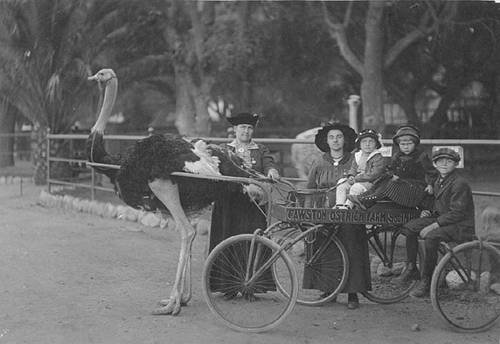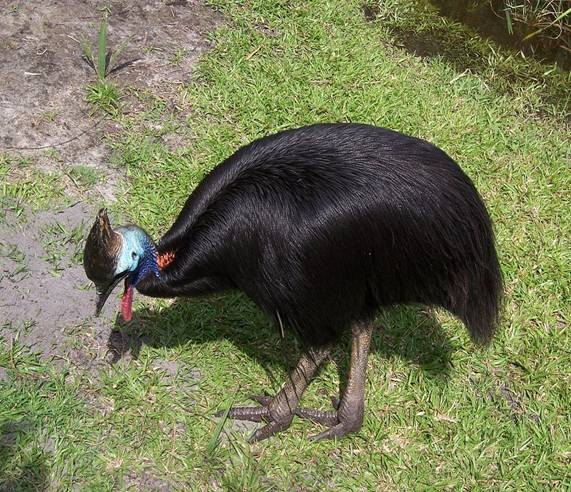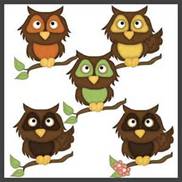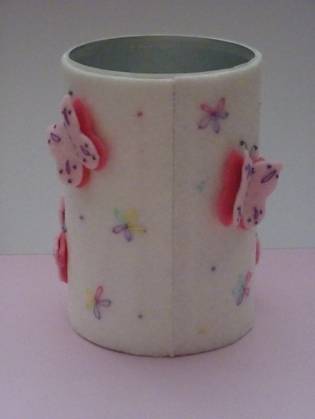
Salty Sam’s Fun Blog for Children
Number 196
Animals That Fly and Birds That Don’t
Hello Everyone

This might seem like a very strange title for my blog post this week. When you think of birds, one of the first things you think of is that they fly. But of course when you think of penguins and ostriches you realize that of course this is not true of every bird.
As for the animals flying, well of course most of them don’t have wings that keep them in the air for hours on end, but quite a few of them have a way of either propelling themselves through the air or gliding through the air for some time which means that they look as though they are flying.
l asked Bill and Bob if they could think of any animals that fly and they told me, “some people in a Boeing 747” – this wasn’t much help. Of course if you put anything inside an aeroplane like a jumbo jet it would fly!
Have you ever heard the expression ‘as dead as a dodo’?
A dodo is an extinct bird.
A dodo was a flightless bird. lt lived on the island of Mauritius in the lndian Ocean. lts nearest living relative, they say, is the pigeon; although you might not think that they look much like pigeons and they were certainly a lot bigger.
Dodos were large birds measuring up to about a metre in height. lf you have heard of a dodo but don’t know what it looked like, there is a picture of it at the top of my post. No one has seen one alive since 1662 and it is widely thought that humans played a big part in its disappearance.
Today, there are about forty species of birds that don’t fly.
The best known are the penguins, ostriches, emus and kiwis. You may have also heard of the kakapo, cassowary and rhea if they live in your part of the world.
Scientists think that birds that don’t fly, evolved that way because they had no predators (other animals that wanted to eat them) where they lived, so there was no need to fly; there was nothing to get away from in a hurry.
New Zealand has more species of flightless bird, like kiwi and penguins, than any other country because until the arrival of humans there about a thousand years ago there were no large land predators.
Another important reason why a lot of the birds there didn’t fly was that they had plenty of food around them; they did not have to travel long distances to search for something to eat.
One thing that you notice about flightless birds is that they often have more feathers than birds that fly. Ostriches for example, look almost fluffy they have so many. These feathers can act as insulation against the heat.
Ostriches are the largest flightless birds and it is easy to keep them in captivity because they don’t need to be caged; they just need to be penned in like cows and sheep. ln fact, they were once farmed for their feathers. At one time these feathers were used a lot for decorating women’s fashion garments, boas and hats. They could also be used for making feather dusters.
A lot of birds that are farmed have lost their ability to fly, like ducks and chickens; although their wild relatives still do.
Ostriches lay the biggest eggs in the world. They are 24 times bigger than a chicken’s egg.
Ostriches are native to Africa. They are not only the biggest bird in the world but they are the fastest runners. They have long necks and long legs and can run up to 70km (43 mph) per hour.
This gave people the idea of using them to pull small carts, just like they would use horses. Nowadays, they are ridden in races by jockeys, so they must be very strong as well.
The second largest bird in the world is the emu, reaching a height of two metres, which is taller than most humans. This bird is native to Australia and is found in most places there where there is open grassland.
Like ostriches, emus are fast runners, reaching up to 50km (30mph) per hour.
They walk long distances, and are even known to swim. lt is emu fathers that incubate emu eggs, this behaviour is similar to some penguins; and little emus are reared by their fathers too. An emu is featured on the Australian coat of arms.
Large, swift-running, flightless birds often have predators, but with their ability to run, swerve and scratch with powerful claws, they have other ways of protecting themselves besides flying away.
But there are other birds that don’t have these abilities, and are much more vulnerable if predators like cats or rats are introduced to the places where they live. The kakapo (or owl parrot) which lives on quite isolated islands in the South Pacific is an example of a bird that has suffered in this way.
lt is a sweet-looking bird which can’t fly. lt climbs trees to eat its favourite food of seeds, and it nests in burrows. lt is able to live to over one hundred years old. There are now only just over one hundred of them left. lsn’t that sad?

So what about animals that fly? Well of course many insects have wings, like bees and beetles, but there are animals that have them too – like bats. There are about 1,240 species of bats worldwide.
Other animals have evolved in a way to allow them to glide through the air. This is especially useful in places like the rainforest where there are many tall trees. Animals can climb and jump from tree to tree without going down to the forest floor. The ability to glide means that they can move rapidly between quite widely-spaced trees and this is especially true of Asian forests, particularly Borneo.
ln the South American rainforests, the trees are closer together and the animals there tend to use tails to help them around in the trees rather than gliding abilities. This is another example of how animals have adapted themselves to live in their environment through evolution.
There are many different types of animals that glide.
There are gliding lizards, frogs, snakes and even ants. The ants have the ability to quickly get back to the trunk of the tree on which they live if they happen to get knocked off a branch.
Flying lizards and geckos usually have extra skin on the sides of their bodies that can extend in flight to catch the air as they fall: this adaptation works in the same way as a hang glider. Some have extra skin on their tails as well. Otherwise, they spread their ribs to make themselves flatter.
The frogs have skin between their toes so that they have webbed feet.
There are five flying snakes; they glide by flattening their bodies rather than employing extra skin. The largest is over a metre long.
The paradise tree snake can glide for up to 100 metres. lt glides by opening up its ribs and making its body concave to catch the air as it jumps between trees. lt can even make turns in flight.
There are also gliding squirrels. They live in northern forests and tropical ones. Flying squirrels, as they are called, can glide up to 200 metres. They do this by opening a flap of furry skin stretching each side of their bodies from their wrists to their ankles. They use their tails a little like an air brake! Colugos (commonly called flying lemurs) glide in the same way.
Gliding is more like going down on a parachute than flying through the air using wings.
There are also animals that live in the water that have the ability to jump long distances in order to get away from anything chasing them.
There are over fifty species of flying fish; most of them live in the sea. Some have been seen to glide for hundreds of metres along the crests of waves, staying in the air for about 45 seconds.
Flying squids behave in a similar way, being able to manage a 50m flight. The flying squids use their mantle fins as wings, and some also propel water out of their bodies in order to create thrust which will push them above the water.
Have you ever seen a flying fish? Bill and Bob said that one of their goldfish jumped out of its tank once, but l don’t think that counts!
Bye bye everyone – don’t forget to subscribe to my blog!
lf you like my blog, please support it by telling all your friends and followers about it.
Thank you!
And see you again next Fun Friday!
Love and kisses
Salty Sam

www.christina-sinclair.com


Bill and Bob’s Joke of the Week![]()
![]()
Bob: What kind of bird steals from banks?
Bill: l don’t know. What kind of bird steals from banks?
Bob: A robin!

Salty Sam © Christina Sinclair 2015
Unauthorized use and/or duplication of material from this blog without express and written permission from this blog’s author and owner is strictly prohibited.
Links may be used to www.christina-sinclair.com

Picture Gallery

Penguins use their flippers to swim rather than fly

An ostrich

An ostrich cart

An ostrich racing cart

Ostrich racing

Ostrich feather coat

Feather fans

A feather fan

Queen Victoria’s bonnet worn at her Golden Jubilee 1880

An emu

An emu

A kakapo

A cassowary

Rheas

The Australian coat of arms – a red kangaroo and an emu

A lady bird is a flying beetle

A bat in flight

A gecko with skin flaps along its sides and between its toes

A gliding lizard

A gliding frog

A gliding frog

Webbed feet

A paradise tree snake

A gliding snake flattened for flight

A gliding ant

A flying squirrel

A colugo

A colugo in flight
(live science.com)

A flying fish have fins that look a little like wings

Flying squid

A Reunion Island Dodo

A dodo


 THE SALTY SAM NEWS DESK
THE SALTY SAM NEWS DESK

Bill and Bob have been preparing questions for their team for their next Friday afternoon class quiz. Henry and Emily often come round to Primrose Cottage, where Bill and Bob live, to help too, because they are in the same team.
Miss Pringle started the idea as a way to get the children to do some research on topics by themselves, but the Friday afternoon quiz time soon became a hit and a frequent feature of the school week.
She realized that the competitive element to the lesson made the children pay attention at the end of what could be a tiring week of lessons and the questions each team create to try and outsmart their rivals have increased their general knowledge hugely.
Friday afternoon quizzes can become very noisy and exciting, so Miss Pringle is very grateful to go home afterwards, sink into an armchair, put her feet up and look forward to her weekend. ![]()
See if you can answer Bill and Bob’s questions – they all have the word ‘bird’ in them…
Can you complete these words?
- seen from above = bird_ _ _ _ _ _ _ _
- idiot = bird_ _ _ _ _
- food for birds = bird _ _ _ _
- a sleeping place for pet birds = bird _ _ _ _
- a place to put food out for wild birds = bird _ _ _ _ _


Bill and Bob decided to take some more of their mystery photographs for you this week as well.
They found some things on the top of their dad’s desk.
Can you see what they are?
 1
1
 2 3
2 3

 4
4
5



*********************
*********************


Crafty Tip
This is how to make two hanging decorations to match the star topper from Blog Post 183.
lf you like making things out of felt, here are two ideas that may end up on your Christmas tree.

First, cut out the individual pieces in paper then felt. Use whatever colours you would like to.

When cutting small shapes, cut into them rather than around them and press the paper pattern firmly down with your thumb as you cut out the shapes in order to make a crisp edge.
You may want to buy ready-made eyes.

OWL
- Embroider feathers onto the chest.
- Sew the chest onto the body using small over-sew stitching.
- Add the eyes to the head with a French knot in white embroidery thread to add a shine to the eyes (wind the thread 2 or three times around your needle).
- Add the claws and ears and beak using embroidery thread.
- Sew front body to back body incorporating a loop of narrow ribbon as you work but leave a gap at the bottom.
- Lightly stuff and continue sewing up the bottom of the body.

FlSH
- Decorate the fins and tail with embroidery.
- Sew the eye to the front panel by using a black French knot (wrap the embroidery thread around the needle three times).
- Sew the two white sides together leaving a gap at the bottom.
- lncorporate a loop in the top of the fin.
- Sew across the top of the body so that the stuffing won’t go into the top fin.
- Sew the front panel onto the body around the nose.
- Lightly stuff the body and close the gap.



BLOW MY FOGHORN!!!

PLUS
Salty Sam fans can join in with their comments and share them with children all over the world. You will need to ask permission if you are not an adult.
Enter your e-mail address to subscribe to my blog and receive new Salty Sam Blog Posts for free by e-mail every week. Your address will be kept private and will not be shared with any third party.
Sign me up at the side bar




lt’s the Weekend!

HOW TO MAKE A 3D BUTTERFLY PENClL POT
This pot is base on a hot chocolate canister (500g) the canister must be small enough to wrap one piece of felt around and the sides must be straight.

You will have to empty the contents out into a storage jar and wash the container while it is still new – don’t over-soak it and let it dry thoroughly.

Cut out some butterflies in two different shades and embroider the top layers if you would like to.
Stitch the two layers together along the centre of the body using running stitch.

Cut a piece of white felt to fit around the canister – measure it carefully and cut a piece of paper to check the fit before you cut the felt.
The piece of felt in the photograph is 27.5cm x 12.8cm.
Position the butterflies onto the base and one by one anchor them on with sewing thread at the top and bottom of the body.


Remember that the butterflies each end will come together when the felt ends are sewn together.
Embroider a head and antennae on each butterfly.
Use a French knot (wind the thread 5 times around the needle) for the head and ends of the antennae and back stitch for the antennae.

What you do between the butterflies is up to you. You can:
- Leave the felt blank
- Stitch swirly flight paths behind the butterflies in running stitch
- Sew flower shaped buttons onto the background. (Not too big and heavy)
- Add flower-shaped pieces of felt
- Embroider flowers onto the background

Using sticky tape, cover the canister with the piece of paper you used to measure the felt. This will cover the printing in order that it will not show through the felt.
You don’t have to use white and pink felt. You can use other colours to match your room.
Over-sew the ends of the felt together very loosely wrong sides together and slip the felt sleeve over the canister.




TIP
Of course, you could have grey bats flying on a dark blue background if you would prefer!

Please note that the material on this blog is for personal use and for use in classrooms only.
It is a copyright infringement and, therefore, illegal under international law to sell items made with these patterns.
Use of the toys and projects is at your own risk.
©Christina Sinclair Designs 2015

Answers to the News Desk Quiz
- seen from above = bird’s eye view
- idiot = birdbrain
- food for birds = bird seed
- a sleeping place for birds = bird cage
- a place to put food out for wild birds = bird table

A bird table
The mystery photographs are: a pencil, a USB stick, a computer mouse, a sticky tape dispenser and a very battered, old pencil sharpener that he has had since he found it in a drawer somewhere.
Did you get them all?


For an Embroidery Stitches Chart
Check out Blog Post 3


Sweet blog! I found it while searching on Yahoo News. Do you have any suggestions on how to get listed in Yahoo News? I’ve been trying for a while but I never seem to get there! Appreciate it
l have no idea Madalene. l am sorry.
But l am glad you like my blog.
Hi you guys – great blog!
Thanks!
What i don’t understand is how you’re not actually a lot more smartly-favored than you are now. You are very intelligent. Your stuff’s nice.
Thank you!
This is very interesting, You’re a very skilled blogger.
I have joined your rss feed and look forward to seeking more of your magnificent post.
Also, I’ve shared your web site in my social networks!
Thank you Susan. lf you would like to advertise on by blog, please get in touch.
You should take part in a contest for one of the best blogs on the web. I will recommend this site!
Thank you Reva!
I surprised with the research you made to make this particular publish amazing. Wonderful job!
Thank you!
Wonderful blog! Do you have any hints for aspiring writers?
I’m hoping to start my own site soon but I’m a little lost on everything.
Would you suggest starting with a free platform like WordPress or go for a paid option? There are so many choices out there that I’m completely confused .. Any suggestions?
Bless you!
l am on WordPress Thurman.
Thank you for the auspicious writeup. It in fact was once a amusement account it. Look complex to more added agreeable from you! However, how could we keep in touch?
Thanks Tracy.
My e-mail address is on the home page.
That is very interesting, You are an overly skilled blogger.
I’ve joined your feed and look forward to in the hunt
for extra of your fantastic post. Additionally, I have shared your site in my social networks
Thank you very much Wayne, that is very kind of you.
l am grateful to all the visitors who spread the word about my blog. 🙂